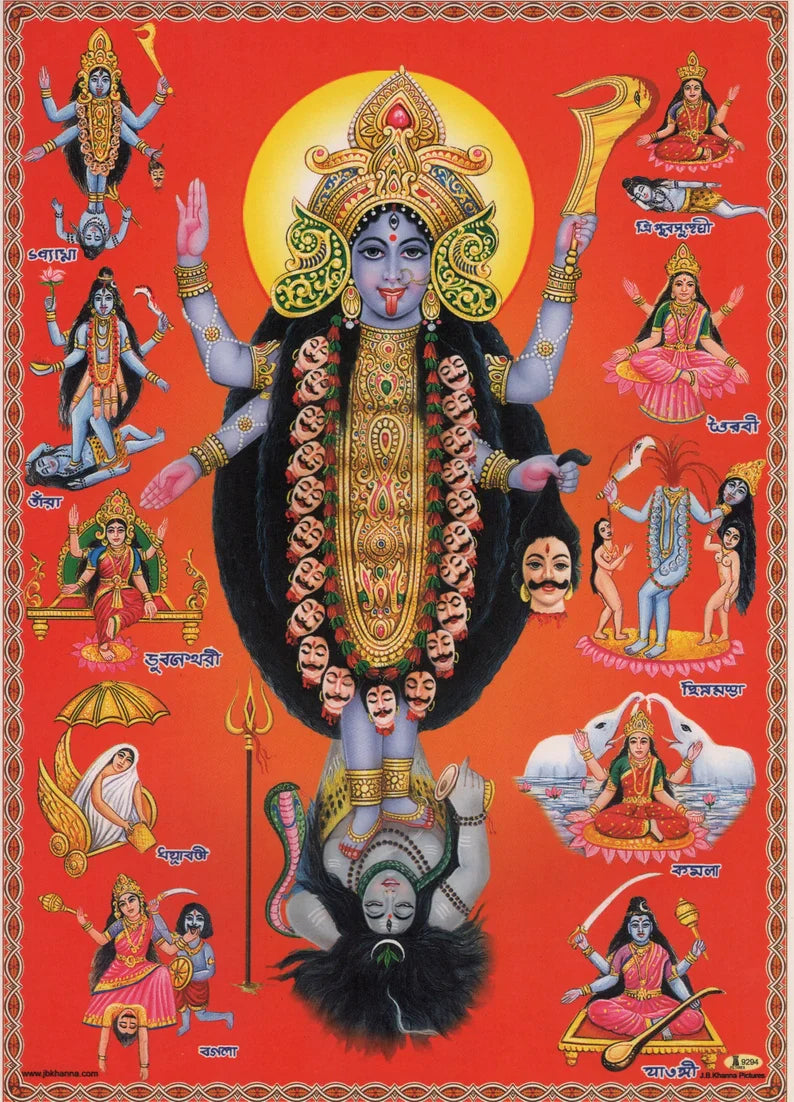Introduction
Goddess Kali, a significant deity in Hindu mythology, is often misunderstood due to her fierce appearance. However, she is much more than just a goddess of destruction. Kali embodies the concept of universal power, time, life, and death. This blog aims to delve into the 12 forms of Goddess Kali, each unique in its symbolism and significance.
The 12 Forms of Kali
Adya Kali
Significance and Rituals: Adya Kali, one of the Dasha Mahavidyas, is worshipped fervently, especially in West Bengal. She represents the primal power and is considered the ultimate form of divinity in Hindu religion.
Connection to Other Goddesses: Adya Kali is often associated with other goddesses like Durga, Parvati, and Kali, symbolizing the interconnectedness of these divine forms.
Matangi Kali
Significance and Rituals: Matangi Kali is the ferocious form of Saraswati, the Goddess of Knowledge. She exists at the fringes of organized Hindu religion and is often given offerings of stale food.
Connection to Other Goddesses: Known by the name Chandalini, Matangi Kali is rarely worshipped at home but holds a significant place in tantric practices.
Chhinnamasta Kali
Significance and Rituals: This form of Kali is perhaps the most shocking, as she is depicted with a decapitated head. The flowing blood from her neck is consumed by her own severed head.
Connection to Other Goddesses: Chhinnamasta Kali represents the cycle of life and death, symbolizing both creation and destruction.
Shamsana Kali
Significance and Rituals: Shamsana Kali oversees activities at the crematorium and is worshipped only within these sacred grounds.
Connection to Other Goddesses: Unlike other forms, Shamsana Kali is depicted with only two hands and no protruding tongue, making her an extremely human projection.
Bagala Kali
Significance and Rituals: Bagala Kali is a violent form of the goddess, yet her beauty is unparalleled. She is often shown pulling out the tongues of demons.
Connection to Other Goddesses: This form of Kali represents the fierce power of the goddess, capable of both creation and destruction.
Dakshina Kali
Significance and Rituals: Dakshina Kali is the most popular form of Kali in Bengal. She is considered the mother of mercy and is believed to protect her devotees from accidents and misfortunes.
Connection to Other Goddesses: It is said that even Yama, the god of death, fears her name, signifying her power over life and death.
Bhairavi Kali
Significance and Rituals: Bhairavi Kali is often described as the harbinger of death but is also seen as a protective mother.
Connection to Other Goddesses: The main temple for Bhairavi Kali worship is located in Tripura, adding regional significance to this form.
Tara Kali
Significance and Rituals: Tara Kali is unique for her light blue skin and is often depicted covered in a tiger's skin.
Connection to Other Goddesses: This form of Kali represents the fierce yet protective nature of the goddess.
Shodoshi Kali
Significance and Rituals: Shodoshi Kali is depicted as a seductress and is considered a young girl emerging from naivety.
Connection to Other Goddesses: This form of Kali represents the transformative power of the goddess, capable of leading her devotees to enlightenment.
Kamala Kali
Significance and Rituals: Kamala Kali is an incarnation of Lakshmi, the goddess of prosperity and wealth.
Connection to Other Goddesses: This form of Kali is often accompanied by two elephants, symbolizing her grandeur and majesty.
Guhya Kali
Significance and Rituals: Guhya Kali represents the hidden female energy and is closely associated with tantric practices.
Connection to Other Goddesses: This form of Kali is often referred to as Kaleshwari and is considered the wife of Kaleshwar.
Dhumavati Kali
Significance and Rituals: Dhumavati Kali is unique as she is the only widowed goddess in Hindu mythology.
Connection to Other Goddesses: She is often referred to as the "Smoke Goddess" and represents the darker aspects of life.
Benefits and Features of the 12 Forms of Kali
Understanding and worshipping the 12 forms of Kali can bring about transformation and empowerment in one's life. Each form offers different blessings and energies, allowing devotees to connect with universal power and embrace both life and death.
Conclusion
The 12 forms of Kali are not just mythological figures but represent the various facets of life and the universe. By understanding these forms, one can embark on a spiritual journey to attain wisdom, power, and ultimately, liberation.

